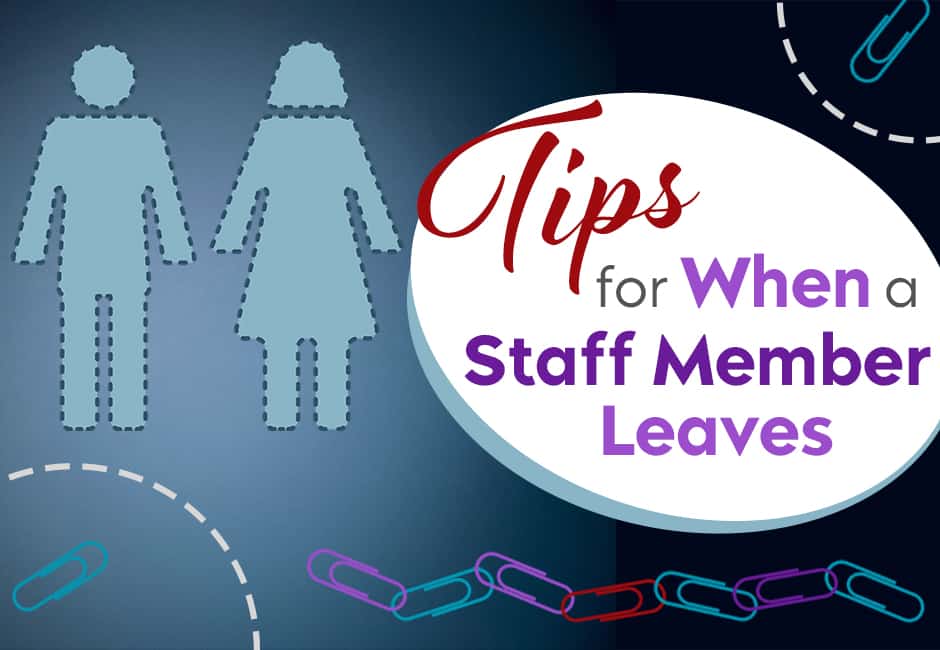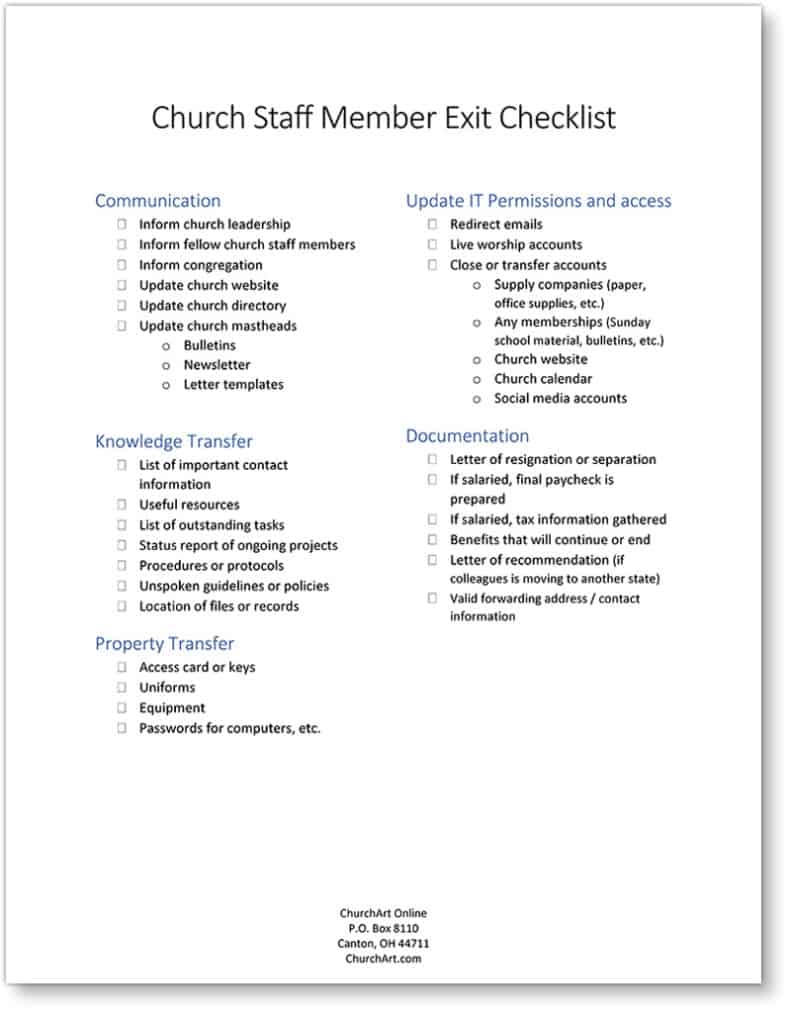
How to Properly Exit a Staff Member From Your Church
Personnel shifts are common in all types of work settings, yet employee exits can be awkward or uncomfortable. This may be especially true in church settings, which some people consider to be more like families than businesses. Having a process in place will smooth out the path and make the experience less emotional for everyone involved.
Yes, you may have “exited” your fair share of church employees before. But have you ever overlooked something and later regretted it? Have you made notes to yourself to ensure that the next exit — and there will be another one — goes better? If so, then you can benefit from a handy checklist.
For example, here are some items you might not think about initially when an employee says goodbye:
- Were any home-office items or devices on loan to the staff member?
- Are any church-related accounts solely in the departing employee’s name? If so, you’ll need to close or transfer them, consulting with church leaders when questions arise.
- Does the employee have a mailbox and key? or access to a church post office box?
- Does the employee know how to disable false alarms for security companies or fire departments?
- How was the person slated to be involved in upcoming tasks, special events, planning sessions, denominational and community happenings, etc.? Will he or she return for any of those?
These are just a few of the loose ends you’ll need to tie up to properly exit each departing staff member. Using a checklist guarantees that you don’t accidentally overlook key steps. It also spares you from having to reinvent the wheel each time, worrying about what you need to account for and retrieve. Plus, a clear transition process smooths the arrival and integration of each new employee.

Remember: Having procedures and protocols in place doesn’t diminish the spiritual aspect of a congregation. Yes, churches are unique employers, with a focus on ministry, education, and Christian service. But they are employers, nonetheless. So don’t hesitate to follow business-like best practices with church personnel. By having human-resources standards in place, a church increases its likelihood of adhering to employment law and treating all people fairly. And covering all the bases helps you avoid risks and mitigate losses.
Policies for church staff members are especially important for hiring and onboarding, performance and salary reviews, and departures and exits. Whether an employee resigns, is let go, retires, or accepts another denominational call or assignment, your church can follow the same steps as other professional organizations.
Read on to learn more about exiting church personnel — and how a step-by-step list makes your job easier and your church stronger.
Steps for Exiting Church Personnel
Depending on the size of your church and office staff, you might follow business theories or best practices such as 4M (Man, Machine, Method, Material). Such philosophies often use maps or diagrams to represent employment elements and interactions. After all, workers use a wide range of tools (especially in the digital age!), perform a wide range of tasks, and maintain lots of files, systems, accounts, and knowledge. That’s why tracking them all is vital to effectively exit a staff member from your church or ministry.
When a colleague leaves, you’ll need to sit down together and review numerous steps. First, however, you might want to give the departing employee a checklist to complete. Include important reminders such as documenting passwords, returning keys and credit cards, informing contacts, forwarding mail and email, and so on.
A church employee who is leaving or transferring likely will have already thought through some of these things. But a checklist offers valuable reminders to smooth the person’s departure.
8 Areas to Assess When a Church Employee Leaves
To help you customize a list for your own congregation, we compiled several exit considerations. Use these suggestions to start creating a positive end date for any church staff.

- Devices and tools. What computers, laptops, phones and other materials belonging to the church need to be returned—and then reissued to someone else? Does the employee have access to a church vehicle? a church credit card?
- Account access. To which password-protected accounts does the employee have access? Examples include email programs, social media accounts, bank and credit-card accounts, computer servers, videoconferencing tools and internal-communications programs (such as Slack or Microsoft Teams), third-party services such as church management programs, directory software, art and media software accounts and more. Collect all passwords and credentials. Then give the new employee his or her own.
- Keys and building access. Be sure to collect (and, if necessary, change) keys, sensor fobs, and passcodes for entry to all church facilities (school buildings, too.)
- Contact information and contacts. When exiting a church employee, you’ll need to update email and mailing addresses. Before leaving, the employee might want to inform his or her contacts about the upcoming change. Ask for the names and information of contacts that a new employee will need. Also ask the departing individual to leave a forwarding address, if desired, for both email and print communications.
- Payroll and benefits. Have your church’s office manager or HR specialist update payroll systems and distribute the final paycheck. Also update health insurance records, retirement plans and other benefit programs. If applicable, issue COBRA information and severance pay.
- Signage. After employees leave, remove their names from the church directory staffing pages. On the church website and signs, replace their name with that of the new hire. Don’t forget to update bulletins, newsletter mastheads, church letterhead and business cards.
- Processes and ticklers. Before a church staff member leaves, ask them to review their work duties and processes — from a weekly, monthly and yearly perspective. Together, review the employee’s schedule and the church calendar to think ahead. What roles and functions will you need to hand off to someone else? Also, what “ticklers” or reminders will need to become someone else’s responsibility?
- Training tips. Before the staff member leaves your church, see if he or she will participate in training the new hire. Even if those individuals don’t meet to work on the transition together, try to build a training plan for the new employee. During an exit interview, ask what the departing employee would have liked to know or learn early on. Also, ask what they think the new staff member needs to know upfront to be successful.
Exiting a staff member from your church is easier and less stressful when you adhere to a well-thought-out process. Personnel changes also bring important opportunities: Your congregation can strengthen its practices and assess its stewardship of resources. For example, while onboarding someone new, you can fine-tune policies about using church credit cards, keys, and church and personal email addresses.
Making improvements now ensures that future transitions proceed even more smoothly. After all, procedures and policies aren’t about only today; they’re about tomorrow and the organization’s ongoing success.
Download our FREE Exit Checklist
Our checklist incorporates many of the items you’ll want to review upon an exit that are discussed above. This document is a great starting point for the proper exit of a staff members. Use the checklist as is or edit it to include other items that are appropriate for your setting.

What tips can you add for exiting a church staff member? What do you wish you had done or known in the past? If you’re a new trainee or employee, what knowledge or tips would have helped you? Please share your suggestions in the comments below!
ChurchArt Team
We love art, are passionate about helping churches create professional-looking communications and are a fun bunch of folks. With an in-tune creative director and a rock-solid team of artists, we will provide the art you’ll want to use, plus templates, puzzles and extras that make your job easier.



